Bellsouth Poultry Equipment Poultry Information Learning Resource Sheets Alternative Feeding Method
Alternative Feeding Method

Many people have a desire to mix their own feeds for chicken and poultry on a small scale. The motives vary from an attempt to save money, a lack of performance or availability of regular bag feed, or perhaps in order to gain more control over the contents of the foodstuffs.
However traditional mixing of the feed ingredients does create several problems. The time, effort, and equipment required to effectively select a variety of feed ingredients, balance the quantities so the birds receive the correct diet, crush and blend to the final product usually ends up being more trouble than it is worth. Add to this the fact that without some preservatives to prevent oxidation of the feed it will quickly go off. This means mixing every few days is essential to maintain the quality, particularly for breeding birds and chicks. Research with the domestic fowl has shown conclusively that the birds can select from a variety of feed ingredients placed before them and balance their diet to maintain good health and high production. Testing has occurred with chicks, growing birds, layers and breeding chickens and poultry and shows excellent performance at all levels. Application of this research allows us to achieve a greater degree of control without the drawbacks of traditional home mix feeds.
I believe it is reasonable to assume that most avian species have the same ability. This means we can use a similar system with quail, partridge, pheasants, ducks, geese etc
This method is called FREE CHOICE as it allows the birds to select from several different grains and also a protein concentrate to allow balance. This allows us to buy whole grain and so save on processing costs, vary the actual ingredients offered, and ensure a varied and well balanced diet.
This technique involves the use of at least two, but preferable three or four grains, and a separate source of protein. The usual is to use the gains most available and allow the birds to eat what they want. The grains can be some or all of the following list; wheat, maize (or corn), barley, oats, lupins, or sorghums - indeed virtually any grain. If only 2 are used, I would suggest wheat and one other. Obviously buying grain from the farmer is the best way to go and will save the most money.
The protein supplement will usually contain meat meal (50% protein), lucerne meal, and a complete premix. The proteins that could be used are fishmeal, powered milk, soybean meal, linseed meal, pea meal, and a variety of other byproduct meals. All will aid in a broad ranging protein mix. Many of these are difficult to purchase whereas the common meat meal, lucerne meal and milk powder are all easily obtained through the local produce store.
With laying birds, a mixture of 24 kg meat, 6 kg lucerne meal and vitamin mineral premix will be a suitable mix. Vitamin mineral premixes with amino acids added will improve performance, especially with light breed layers. For breeding birds, some of the meat meal could be replaced with powdered skim milk (the No Name variety is quite suitable, but avoids synthetic calf milk), up to about 1 kg. If the other protein concentrates are available these also can be added, but be careful of using a lot of lupin meal and linseed meals as these will suppress production if used at a rate of more than a few percent of the total diet. The same mix as for breeding birds can be used with chicks but the premix should also contain a coccidiostat to prevent coccidiosis. The grain selections should also be ground to chick sized pieces.
The birds will consume about 30 kg of protein mix to 70 kg of grains. The exact percentages will vary according to the actual grains used, the temperature, and other seasonal variations.
It is important that birds fed a free choice selection must also have available calcium in the form of shell grit. This may be supplemented by Di-calcium Phosphate. A mineral grit is also required to ensure the gizzards of the birds will do their job of grinding up the food. The birds should have access to both these grits at all times. Pigeon grit is suitable for chickens also.



